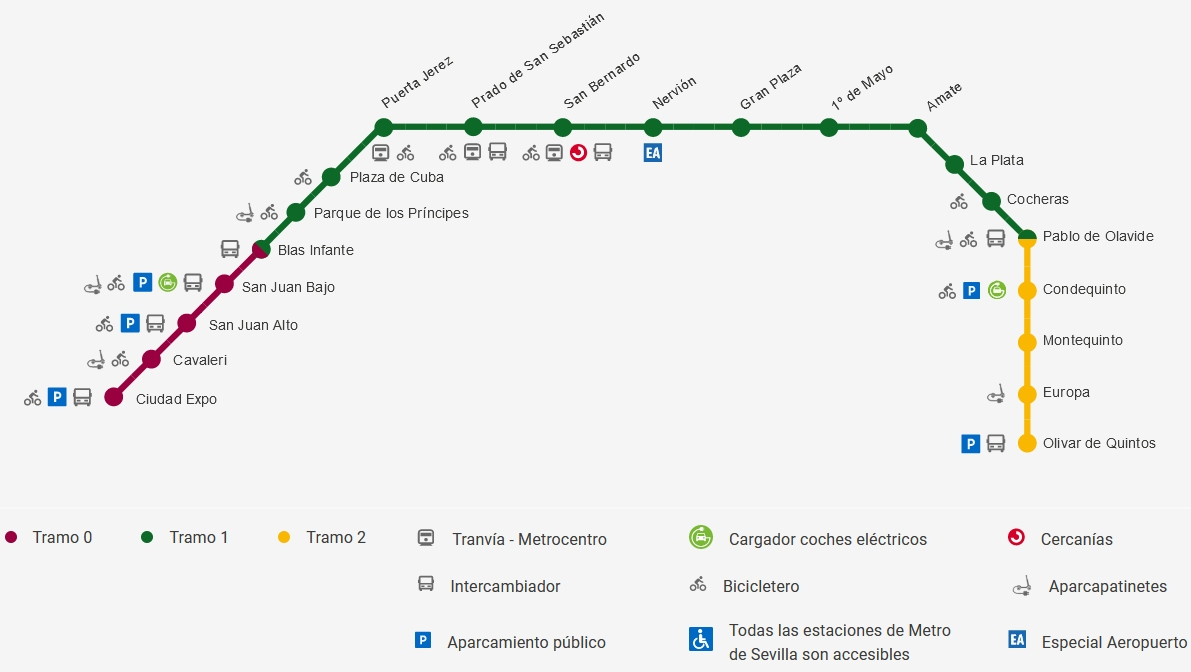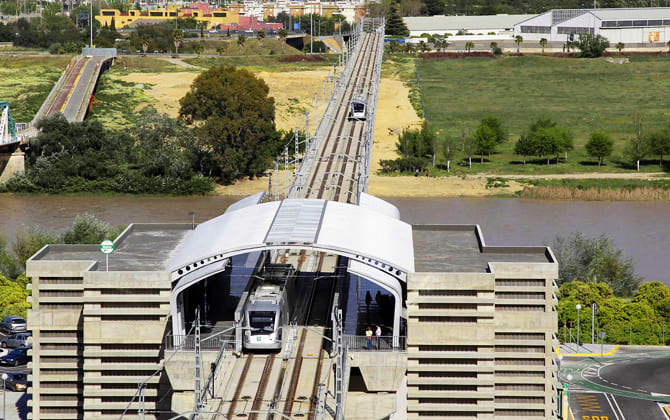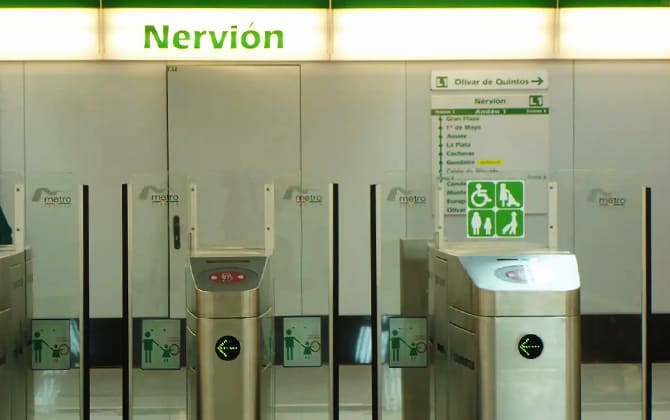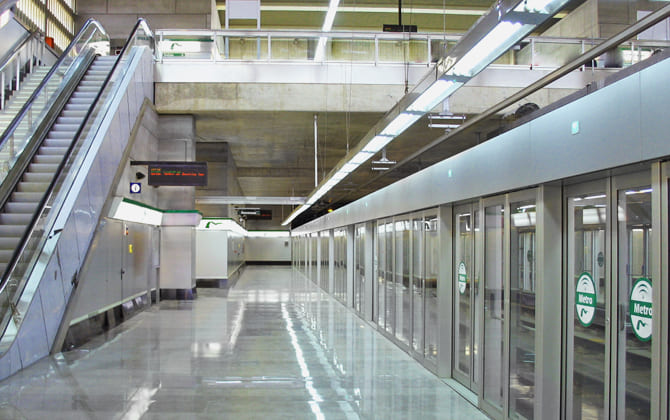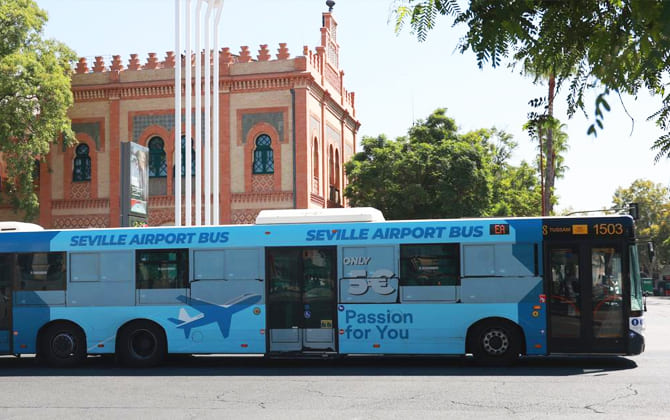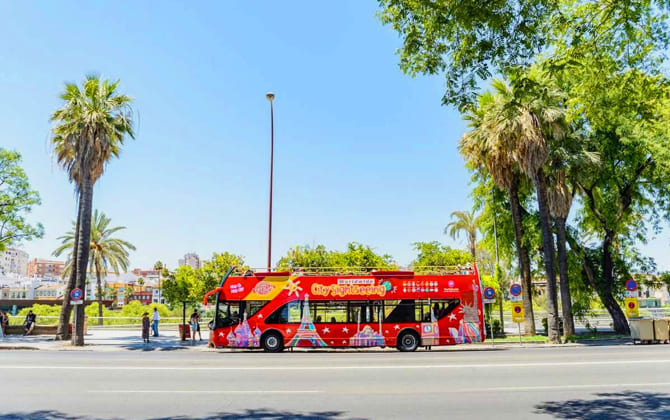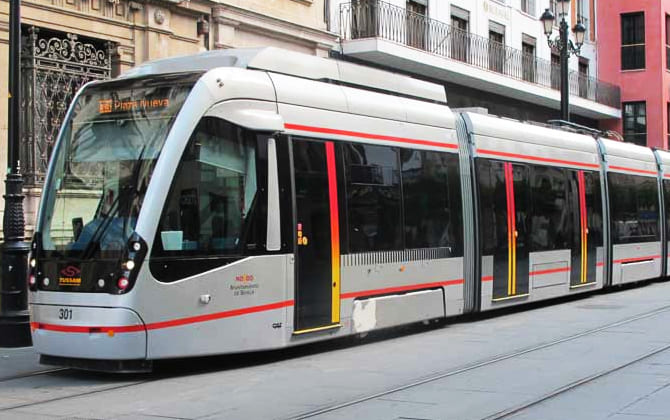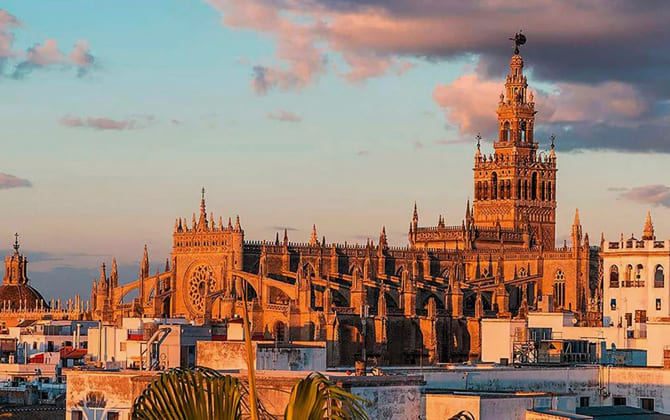The Seville metro system opened in 2009. It has one line with 22 stations. The line runs east-west. It measures about 18 km (18 000 m; 59 055 ft). It links central Seville with Mairena del Aljarafe, San Juan de Aznalfarache, and Dos Hermanas. You can check the Seville metro map at stations or online.
In 2024, over 22 million people rode the metro. Trains are air-conditioned and run often. All stations have elevators and ramps. At San Bernardo, you can change to suburban trains. At Prado de San Sebastián, you can change to the MetroCentro tram or many city buses. The line covers three fare zones: Zone 0, Zone 1, and Zone 2. Fares depend on how many zone borders you cross. Smart station placement means many trips in adjacent zones cost no extra.
A private company runs the metro under the Transport Consortium of Seville. It keeps trains frequent and reliable. The metro is a good choice for daily commuters and visitors.
Seville Metro Map 2026
The Seville Metro Map (2026) shows the current line and planned expansions. Line 1 appears as a bold route from Ciudad Expo in the west to Olivar de Quintos in the southeast. Future Lines 2, 3, and 4 appear as dashed or colored paths. This layout lets riders see how the network will grow. Major interchanges and landmarks appear on the map. The Seville subway map is clear and easy to read.
Click on the map to enlarge it or download the Seville Metro map in PDF format.
Seville Metro Lines and Stations
The Seville metro system has one line. It runs from Ciudad Expo in Mairena del Aljarafe to Olivar de Quintos in Dos Hermanas. The line is about 18.1 km (18 100 m; 59 400 ft) long. It has 22 stations and links suburbs with the city centre.
Zone 0 (West): Cities: Ciudad Expo (park-and-ride, shopping mall) and Cavaleri. River crossing: San Juan Alto and San Juan Bajo.
Zone 1 (Centre): Blas Infante (edge of Los Remedios), Parque de los Príncipes, Plaza de Cuba, Puerta de Jerez (near Cathedral and Alcázar), Prado de San Sebastián (bus hub, tram, university, Parque de María Luisa), San Bernardo (Cercanías trains, tram), Nervión, Gran Plaza, 1º de Mayo, Amate, La Plata, Cocheras.
Zone 2 (Southeast): Guadaíra (above ground, Renfe C-4 connection), Pablo de Olavide (university), Condequinto, Montequinto, Europa, Olivar de Quintos. A future tram-train at Olivar de Quintos will link deeper into Dos Hermanas.
All stations have ticket machines, elevators, ramps and info screens. Announcements and signs appear in Spanish and English. Blas Infante is next to the Feria de Abril grounds. Travel end to end takes about 38 minutes. The system is easy to use and reliable.
Seville Metro Timetable & Operating Hours
The Seville metro timetable is simple. Check it before you travel. First trains depart at 6:30 AM on weekdays and Fridays. On Saturdays, Sundays and public holidays they start at 7:30 AM. These times apply at Ciudad Expo and Olivar de Quintos.
- Peak hours: trains every 4 minutes.
- Off-peak/daytime: every 5–7 minutes.
- Evenings: every 7–10 minutes.
- Late nights (Fri & Sat): until 2:00 AM, about every 15 minutes.
- Other nights: service ends at 11:00 PM.
You can check live Seville metro timings on the official app or station screens. They show “Próximo tren” countdowns. On festival days, service may run later. For the latest info, consult station notices or the website.
Seville Metro Tickets, Prices, and Fares
The Seville Metro uses a zone-based Seville metro fare system. This guide shows each Seville metro ticket option and the Seville metro price. It also covers the Seville metro card. You can buy tickets at station machines. They accept cash and bank cards. Children under 3 travel free.
1. Billete Sencillo (Single Ticket)
A single ticket lets you make a one-way trip. No transfers to buses or trams. It is paper-based and valid for one entry and exit.
- 0 saltos (one zone): €1.35 (~$1.50)
- 1 salto (two zones): €1.60 (~$1.80)
- 2 saltos (three zones): €1.80 (~$2.00)
Tap in at the start and insert at exit. The machine keeps the ticket.
2. Billete de Ida y Vuelta (Return Ticket)
A return ticket covers two single trips. Price is double the single ticket.
- 0 saltos round-trip: €2.70 (~$3.00)
- 1 salto round-trip: €3.20 (~$3.60)
- 2 saltos round-trip: €3.60 (~$4.00)
Use the same ticket for both trips. Keep it until you return. Valid same day.
3. Bono de 1 Día (1-Day Pass)
The 1-Day Pass gives unlimited metro rides for one service day. It covers all zones.
- Price: €4.50 (~$5.00)
Tap in and out each trip. Valid until end of service. Ideal for tourists and day travellers.
4. Bono con Transbordo (Ticket with Transfer) & Tarjeta del Consorcio (Transport Card)
The Seville metro card is a reloadable smart card. It works on metro, buses, trams, and suburban trains. You pay lower Bonometro fares:
- 0 saltos: €0.82 (~$0.90)
- 1 salto: €1.17 (~$1.30)
- 2 saltos: €1.37 (~$1.50)
A 50% subsidy may apply, cutting prices in half. You also get transfer discounts within 2 hours. Buy the card for €1.50 (~$1.70). Load money at machines or kiosks. Tap in and out on each trip.
5. BonoMetro or Bono Sin Transbordo (Ticket Without Transfer)
BonoMetro is a 10-trip metro-only ticket. It costs about €8.20 (~$9.00) for one-zone. That is €0.82 (~$0.90) per ride. Fares for 1 & 2 saltos match the Bonometro rates. No transfers allowed. Tap in and out; one trip is deducted per ride.
6. Bono Plus 45/30 Monthly Pass
The Bono Plus 45 gives 45 rides in 30 days. Price depends on zones:
- 0 saltos: €15 (~$16.70)
- 1 salto: €21 (~$23.30)
- 2 saltos: €25 (~$27.80)
Load it on your Consorcio card. Tap in and out as usual. Unused rides expire after 30 days. Pass is personal and non-transferable.
Table: Ticket Options and Prices
| Ticket Type | Price (€) | Price ($) |
|---|---|---|
| Single (0 saltos) | €1.35 | $1.50 |
| Single (1 salto) | €1.60 | $1.80 |
| Single (2 saltos) | €1.80 | $2.00 |
| Return (0 saltos) | €2.70 | $3.00 |
| 1-Day Pass | €4.50 | $5.00 |
| Bonometro (per ride) | €0.82–€1.37 | $0.90–$1.50 |
| Bono Plus 45 | €15–€25 | $16.70–$27.80 |
Where to buy tickets: All metro stations have vending machines. Some main stations (Plaza de Cuba, Prado de San Sebastián, Nervión) have customer service offices. Switch the machine to English if you need. For the Consorcio card, ask at kiosks or tobacco shops. Always check the machine to select the correct zone. Tap your ticket or card on entry and exit. If the gate does not open, ask staff for help or use the intercom.
Usage Rules & Safety Guide
Validated Ticket
Always have a valid ticket or pass before entering the platform. Riding without one is illegal and may lead to a fine. Keep your ticket until you exit. If you use a contactless card, check it has enough balance or trips.
Entry and Exit
Go through turnstiles one at a time. Use the wider gate for strollers or luggage. Do not tailgate. If your ticket is retained or won’t work at exit, press the help button.
On the Platform
Stand behind the yellow safety line. Let passengers exit before boarding. Watch the gap between train and platform. Wait for the beep and closing doors before boarding. If you miss a train, wait calmly for the next one.
Behavior on the Train
Smoking is banned. Eating and drinking are not allowed (a small water bottle is fine). Use headphones for audio. Give priority seats to elderly, pregnant, or disabled passengers. In crowded trains, move inside to let others board. Keep aisles clear of bags.
Safety and Security
Security staff patrol trains and stations. CCTV monitors the system. In emergencies, use SOS buttons or intercoms. For medical help, call 112. Report unattended items to staff. Watch your belongings in crowds.
Cleanliness
Use station trash bins. Do not litter. Vandalism and graffiti are forbidden and punished.
Accessibility
All stations have elevators or ramps. Follow signs for lifts. Yellow tactile paving guides visually impaired users. Do not block these paths.
Bicycles and Pets
Bicycles are allowed off-peak and on weekends. Use the last car and be considerate. Foldable bikes can ride anytime. Small pets in carriers are allowed. Leashed, muzzled dogs may be restricted by time. Guide dogs ride free.
No Smoking & No Flammables
Smoking, open flames, and hazardous materials are banned.
COVID-19 and Health Measures
Masks are optional. Hand sanitizer may be available. If you feel unwell, keep distance or wear a mask.
Follow Instructions
Listen to announcements in Spanish and English. Follow staff directions during events or disruptions.
Photography
Non-commercial photos are allowed. Do not use flash. Tripods and professional filming need permission.
Customer Service
Ask uniformed staff for help. Major stations have info desks. You can also call Metro de Sevilla during business hours.
Follow these rules for a safe, smooth ride on the Seville Metro.
Connection to the Airport
Airport Bus (Linea EA – Especial Aeropuerto)
This shuttle runs between San Pablo Airport (SVQ) and Plaza de Armas. Stops: Av. Kansas City, Luis de Morales, San Bernardo, Prado de San Sebastián, Paseo Colón/Torre del Oro, downtown.
Schedule
First bus from airport at 5:20 AM. Last at 1:00 AM. From Plaza de Armas, first at 4:30 AM. Last at midnight.
Frequency
Every 20 minutes in daytime. Every 30 minutes early morning or late evening.
Fare
One-way ticket costs €4.00 (~$4.45). Buy from the driver with cash. Consorcio cards are accepted but offer no free transfer.
Luggage
Buses have racks and space under seats. No extra charge for bags.
Boarding locations
At the airport, exit arrivals and turn right. In the city, catch it at Prado de San Sebastián or other stops on the route.
Taxi
Official taxis stand outside arrivals. Flat rate to city center is €24.98 (~$27.75) on weekdays 7 AM–9 PM. At night and weekends it is €27.85 (~$30.90). During Holy Week and Feria it rises to €34.79 (~$38.60). Luggage is included.
Ride-hailing / Private Transfers
Uber and Cabify operate in Seville. Airport pickups are at the public parking area. Prices are similar or slightly higher than taxis. Pre-booking enables cashless payment.
Car Rental
Major rental companies operate at SVQ. The airport is about 10 km (10 000 m; 32 808 ft) from the city via A-4 and SE-30. Expect a 15–20 minute drive.
Train
There is no train to the airport. The nearest station is Santa Justa. You must take a bus or taxi from there.
Metro (future)
Metro Line 2 may serve the airport in future plans. This is years away, so don’t expect a metro link now.
For budget travel, take the EA bus for €4. For comfort or late flights, take a taxi for ~€25–€35. Ride-share apps offer another option. Allow at least one hour from city center to airport. Enjoy Seville!
Seville Hop-On Hop-Off Bus Guide
The hop-on hop-off (HOHO) bus by City Sightseeing is a red double-decker. It lets you see Seville at your own pace. You can jump off at attractions and catch the next bus.
Route and Stops
The bus loops around the city. It has about 14 stops. Key stops: Torre del Oro, Plaza de España, Acuario de Sevilla, Isla Mágica, Macarena, and Triana. It covers the historic center and nearby areas you can’t reach on foot. A full loop takes about 75 minutes.
Schedule and Frequency
Buses run daily from 10:00 AM to 9:00 PM. A bus comes every 30 minutes. In summer, hours may extend later. In winter, loops may start earlier. Always check the current timetable.
Tickets and Prices
A 24-hour ticket costs €25 (~$28). Child tickets (ages 5–12) cost €13 (~$15). Kids under 5 ride free. A 48-hour ticket may cost the same during promotions. You can buy tickets online or at main stops like Torre del Oro. Many hotels also sell or voucher the tickets.
How it works
Your ticket activates on first boarding. A 24-hour ticket bought at 11:00 AM is valid until 11:00 AM next day. You may hop on and off as much as you like. The bus has an open top for views and a lower deck with air conditioning.
Audio Guide
The bus offers recorded commentary in several languages. You get free headphones when you board. Commentary is in English, Spanish, French, German, Italian and more.
Major Highlights Covered:
- Seville Cathedral & Giralda
- Real Alcázar
- Plaza de España
- Santa Cruz quarter
- Triana
- Isla de la Cartuja (Isla Mágica, Monastery)
- Macarena
- Museum of Fine Arts
- Torre del Oro
The bus stops close to 10–15 top sights. Some require a short walk from the stop.
Extras
Some tickets include extras. You may get a walking tour or discounts at attractions. The Seville Pass bundles a 48-hour HOHO ticket with entry to the Alcázar and Cathedral for €59 (~$65).
Using the Bus
Start at any stop, but Torre del Oro is popular. Staff wear red uniforms. They scan online tickets or sell new ones. They give you earphones and a route map. Press the stop button or tell staff before you want to get off.
Timing
The 30-minute frequency means slight waits. If you miss one, use that time to sightsee or grab coffee. The last bus of the day starts around 7:00 PM to finish by 9:00 PM. Plan to avoid missing the last loop.
The HOHO bus eases walking and gives a city overview. In summer, use sunscreen and bring a hat. In rain, cover the top deck or ride below. Enjoy the views!
Taxi Services in Seville
How to Recognize & Hail
Official taxis are white with a yellow stripe and the city coat of arms. A green roof light means it is free. Hail on the street or find taxi ranks at stations, major squares, and hotels.
Fares & Meter
Seville taxis use a meter. Day rate (7 AM–9 PM weekdays) is lower. Night and weekend rate is about 20% higher. The base fee is around €1.33 (~$1.50) by day and €1.66 (~$1.85) at night. The meter adds about €0.90–€1.10 (~$1.00–$1.20) per km and a fee per waiting minute.
Typical short rides in the center cost €5–€8 (~$5.50–$9.00). Longer trips may be €10–€12 (~$11–$13). No need to memorize rates; just check the meter.
Supplements
Some rides have small extra fees:
• Santa Justa station start (€1)
• Large luggage (€1 per piece)
• December 24/31 nights
These are set by the meter.
Ordering a Taxi
If you can’t hail a taxi, call a dispatch service or use an app. Key numbers: Radio Taxi +34 954 580 000, Tele Taxi +34 954 622 222. Apps like Free Now also work. A small call-out fee (about €1) may apply.
Uber/Cabify
Uber and Cabify operate in Seville. They use licensed vehicles. Prices are similar to taxis. They offer app booking and cashless payment.
Payment
Most taxis accept credit cards. Look for a Visa/MasterCard sticker. Ask “¿Puedo pagar con tarjeta?” if unsure. Carry some cash for small fares. Tipping is not required but rounding up is common.
Language
Many drivers know basic English. Show your destination on a map if needed. Major landmarks are usually understood.
Safety
Official taxis are safe and licensed. Ensure the meter runs at the start. Report any issues to the taxi rank or company. Scams are rare.
Taxi Stands
- Plaza Nueva
- Puerta de Jerez (metro entrance)
- Santa Justa station
- Plaza de Armas (bus station)
- Alameda de Hércules (nightlife area)
- Torre del Oro (riverfront)
Special Tips
In rain, call a taxi early to avoid queues. For very early flights, book a taxi the day before. Taxi lines form after big events, so plan ahead.
Use official taxis only. Enjoy quick and reliable rides around Seville.
Future Expansion Plans
Line 3 (Under Construction)
Line 3 will run north–south. It will link Pino Montano in the north with Los Bermejales in the south. It will serve dense areas like Macarena and Avenida de la Paz. It will intersect Line 1 at Prado de San Sebastián. Construction started in early 2022 and ground works began in 2023. By April 2024, workers laid the first tracks for a maintenance spur in Pino Montano. The work is split into north and south segments. The north segment (Pino Montano to Prado) should finish by 2030. It will serve about 120 000 residents and carry 13 million passengers per year. The south segment (Prado to Los Bermejales and possibly Bellavista) is still in planning. No start date yet. Funding comes from regional, national, and EU sources. Once done, Line 3 will bring metro access to Macarena and northern Seville. It will improve north–south travel.
Line 2 (In Project/Planning)
Line 2 is in planning. It will run east–west from Torreblanca/Sevilla Este near the FIBES centre to Torre Triana/Camas. It will pass Santa Justa station and the city centre. Early plans did not include the airport. In 2024 the government said the study will consider an airport extension. They will also study extending west past Camas. In 2024 the Junta de Andalucía started a 20-month update study. They expect a final plan by mid-2026. Then comes environmental review, public consultation, and tender. No construction has started. The region set aside about €1.3 million (~$1.5 million) for studies through 2027. If all goes well, work could start in the late 2020s and finish in the early 2030s. Line 2 will run underground. It will serve Sevilla Este, link Santa Justa to the metro, and cut road traffic.
Line 4 (Planned Circular Line)
Line 4 is a future ring line. It will circle the city centre and link all other lines. Some parts may run on the surface in Cartuja. Most will be underground. It will connect Santa Justa, Prado, Macarena, and Los Remedios. Planning is minimal and no route is final. The focus is on Lines 3 and 2. Line 4 may start in the 2030s.
Other Transit Projects
Other projects include trams and BRT. A tram in Alcalá de Guadaíra will link to Line 1 at Pablo de Olavide or Guadaíra. A tram in Dos Hermanas may extend from Olivar de Quintos. The MetroCentro tram now runs to San Bernardo. BRT electric buses may cover part of Line 2’s route. A commuter rail spur to the airport is under study.
Impact
When these lines open, Seville will have four metro lines. Line 3 may open first, late this decade. Line 2 could follow in the early 2030s. Each line will add about 18 stations. The network will serve new districts, suburbs, the airport, and Santa Justa station. Line 4 will close the loop. Transfers will be easier and crowding will fall. The city invests to cut car use and meet environmental goals. For visitors in 2026 these lines are not yet ready. But by 2030 you may ride from the airport or Santa Justa directly downtown.
Tourist Attractions Near Seville Metro Stations
- Seville Cathedral & Giralda Tower – Puerta de Jerez station. 400 m (1 312 ft) walk north. The Gothic cathedral is the world’s largest. The Giralda bell tower offers panoramic views.
- Real Alcázar – Puerta de Jerez station. 400 m (1 312 ft) from the cathedral. This royal palace has lush gardens and Mudéjar architecture.
- Torre del Oro – Puerta de Jerez station. 300 m (984 ft) along the river. The medieval watchtower hosts a naval museum.
- Plaza de España & Parque de María Luisa – Prado de San Sebastián station. 250 m (820 ft) walk. The 1929 expo plaza has tiled alcoves and a canal. The park has the Archaeological Museum (~500 m; 1 640 ft).
- University of Seville – San Bernardo station (100 m; 328 ft) or Prado de San Sebastián (200 m; 656 ft). The historic tobacco factory houses the university’s main building.
- Barrio de Santa Cruz – Prado de San Sebastián station (500 m; 1 640 ft) or Puerta de Jerez (500 m; 1 640 ft). This old Jewish quarter has narrow lanes, plazas, and tapas bars.
- Triana Neighborhood & Market – Plaza de Cuba station. 600 m (1 970 ft) across the San Telmo Bridge. Famous for flamenco, ceramics, and its market. Parque de los Príncipes station is 1.2 km (3 937 ft) from Triana’s core.
- Seville April Fair (Real de la Feria) – Blas Infante station. 300 m (984 ft) to the fairground gate. During Feria de Abril, metro runs 24 h at this stop.
- Ramón Sánchez-Pizjuán Stadium – Nervión station. 400 m (1 312 ft) walk. Home of Sevilla FC, with guided tours available.
- Shopping District (Nervión) – Nervión station. Direct access to Nervión Plaza mall, cinemas, and eateries. El Corte Inglés and Los Arcos mall are nearby.
- Archaeological Museum & Plaza de América – Prado de San Sebastián station. 700 m (2 297 ft) through María Luisa Park. The museum and another arts museum sit at Plaza de América.
- Isla Mágica Theme Park – Accessible by bus from Puerta de Jerez station or future Line 3. This Cartuja Island park has rides and shows for families.
- Metropol Parasol (Las Setas) – Puerta de Jerez or Prado de San Sebastián stations, then 1.2 km (3 937 ft) walk. The wooden “mushrooms” offer city views from their rooftop walkway.
